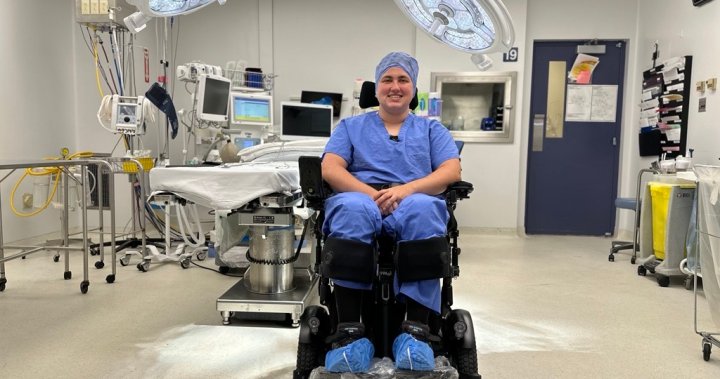RJ Roggeveen, a medical student at Dalhousie University in Halifax, Nova Scotia, is redefining accessibility in medical education. As the first student in the university’s history to navigate medical school and surgical training using a standing wheelchair, Roggeveen is not only achieving his personal ambitions but also inspiring systemic change within the medical field. His journey, marked by resilience and innovation, serves as a beacon of hope for aspiring medical professionals with disabilities.
Roggeveen’s path to medical school began with an unforeseen challenge. A roller-skating accident led to a gradual loss of strength and coordination in his legs, severely impacting his mobility. Despite this setback, his dream of becoming a doctor remained undeterred. He found support through Dalhousie’s Indigenous admissions pathway, a program designed to encourage and assist Indigenous students pursuing higher education. This pathway proved instrumental in his application and acceptance into the medical program, marking a historic first for the university – admitting a student who uses a wheelchair.
Roggeveen’s presence at Dalhousie initiated a wave of change in accessibility practices within the medical program. From the moment he entered the simulation rooms, he actively engaged with faculty and staff, identifying areas needing modification. This collaborative approach led to the pivotal integration of a standing power wheelchair, a device that elevates him to the height of an operating table, enabling full participation in surgical procedures. This innovation proved crucial in allowing Roggeveen to experience the full spectrum of medical training, mirroring the experiences of his able-bodied peers.
A defining moment in Roggeveen’s journey and in the history of accessible medical education arrived with the successful completion of his first surgery using the standing wheelchair. This milestone, meticulously planned and executed, underscored not only Roggeveen’s determination but also the university’s commitment to inclusive practices. Established protocols, including thorough sterilization of the wheelchair prior to entering the operating room, ensured the procedure’s smooth and safe execution. This groundbreaking achievement solidified the viability of incorporating assistive technology into surgical training, setting a precedent for future accessibility advancements.
Roggeveen’s efforts have garnered widespread acclaim within the Dalhousie medical community. Faculty members, including Samuel Jessula, an assistant professor and surgeon who mentored Roggeveen, recognize his significant contribution to enhancing accessibility in medical education. Jessula, who worked closely with Roggeveen from his early days in the program, recalls initial concerns about potential barriers. However, through collaborative brainstorming and proactive planning, they devised strategies to integrate Roggeveen seamlessly into the surgical environment. This collaborative approach not only benefited Roggeveen but also fostered a culture of inclusivity, prompting the university to reassess its accessibility practices across all aspects of the program.
Roggeveen’s impact extends beyond Dalhousie University. His story serves as a catalyst for change within the broader medical education landscape. His journey highlights the importance of proactively addressing accessibility needs, fostering inclusive learning environments, and embracing innovative solutions to ensure equal opportunities for all aspiring medical professionals. His advocacy underscores the need for institutional change, from classroom design to clinical placements, to accommodate students with diverse needs. He envisions a future where medical programs across Canada proactively implement accessibility measures, creating welcoming and supportive environments for students with disabilities.
Roggeveen’s legacy is one of empowerment and transformation. He has not only broken barriers for himself but has paved the way for future generations of medical students with disabilities. His story embodies the spirit of perseverance, demonstrating that with determination and the right support, individuals can overcome challenges and achieve their dreams, while simultaneously inspiring systemic change that benefits the entire medical community. His journey underscores the crucial message that disability should not limit one’s pursuit of a medical career, advocating for a more inclusive and equitable future in healthcare.

